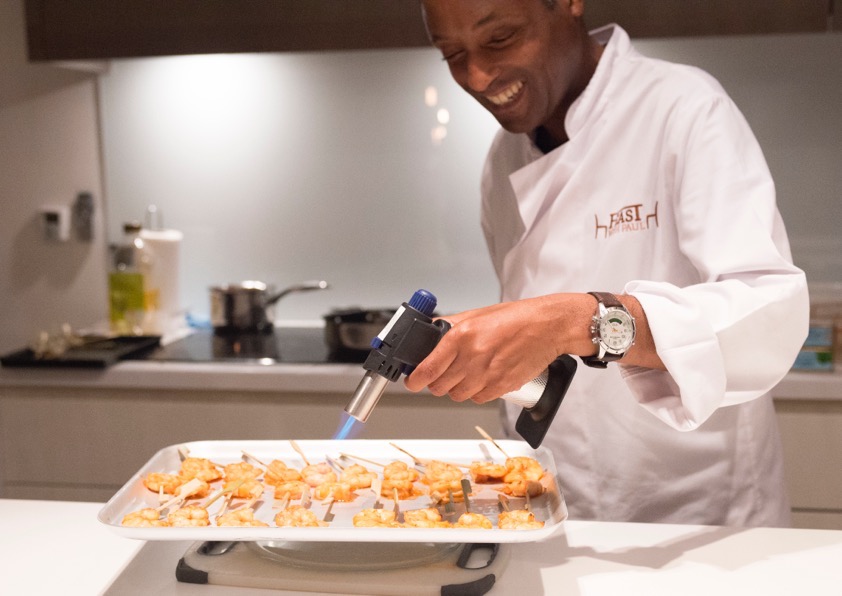It’s autumn. Evenings become darker earlier and it seems a shame to simply go home when there are so many other options that are slightly out of the ordinary to enjoy.
And that is what brought FEAST With Paul together with the Really Helpful Club, an ever-growing network of entrepreneurs and people who want to use their services based on solid personal recommendations. We devised an evening of me preparing and serving food, demystifying certain cooking techniques, and also talking about my MasterChef experience. It seems that no matter how many series are broadcast, there remains a healthy appetite for knowledge and a peek behind the scenes.
The evening started off with warm bread and chicken butter with a fennel-citrus salt for sprinkling. I first served this in 2015 on New Year’s Eve and everyone loved it. People look at me incredulously when I say that I love to brake off a piece from a crusty loaf and run it around a tray that has been roasting a chicken. The runny juices and the more caramelised bits that need little coaxing from the bottom of the tray are like concentrated chicken in a bite. I guess creating a butter you can spread makes it more socially acceptable but the taste sensation is the same.
Miso-glazed prawns
The first part of the evening that generated real curiosity and excitement was the miso-glazed prawns. This was a dish I put together specifically for this event as I wanted to show people how to use a blowtorch for something other than DIY.
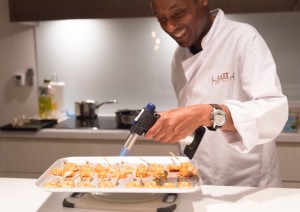
And this is what they looked like, served with Sriracha mayonnaise, once I had demonstrated how quick it was to make mayonnaise from scratch.
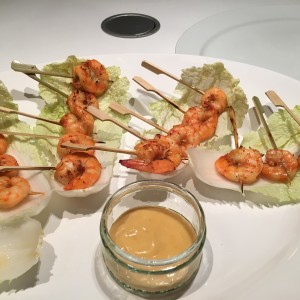
Cooking the perfect steak
Sometimes, the food that gives the greatest pleasure, the simple things, can seem hard to get right. Cooking a steak is one of those things. As soon as the steak came out, the questions came thick and fast. Which cut am I using? Why that cut? I almost always choose sirloin, is that OK? How long to you cook it on each side? You’re resting the steak. Why, and how long would you rest it for?
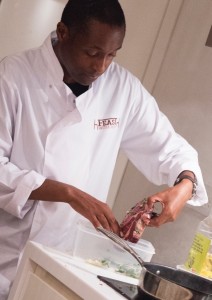
This was a ribeye. I like it because of the amount of fat marbling. I don’t eat a lot of read meat so, when I do, I like to spoil myself with a cut that is full of flavour. I also choose a thick steak from a nearby butcher in Tooting which has always provided quality meat for me. Why there isn’t a butcher in Wimbledon is a topic for another day. I marinated this for a couple of hours with thinly sliced garlic, sprigs of thyme and some light olive oil. Because this steak will start its life in the pan at a high temperature, there is no advantage to using extra virgin olive oil. Did you notice I didn’t add salt?
This is how I cook my steaks. I prefer thicker steaks so I can achieve that seared colour while still keeping the inside pink. If in doubt, go for a narrow, thicker steak in preference to a wide thinner steak.
- Heat a dry frying pan, starting at a low temperature, then increasing the heat to high until it starts to smoke.
- Wipe the garlic and herbs from the steak to prevent them burning.
- Sprinkle salt on one side of the steak and add the steak, salt side down, to the dry pan. Remember: we are oiling the steak, not the pan.
- LEAVE IT ALONE. If I’m feeling impatient, I take a little walk around the kitchen so I am out of reach of the steak and won’t be tempted to touch it. After two minutes the steak should be ready to turn.
- Sprinkle salt on the upper side of the steak, then turn it over.
- Leave for about thirty seconds, then turn the heat down to medium.
- Add a couple of knobs of unsalted butter to the pan, along with the reserved garlic and herbs.
- Baste the steak while keeping it on the heat. If you have a meat thermometer, the centre should register 50°C for rare and 55°C for medium*.
- When the steak has reached the temperature you prefer, place it on a plate, top with the garlic, herbs and a pinch of salt and loosely cover it with foil. The temperature will rise by about a further 5°C while the steak rests.
- LEAVE IT ALONE. You can rest your meat for up to half the cooking time. The heat has shocked the meat. resting time allows it to relax and become juicier and more tender than if you ate it straight from the pan.
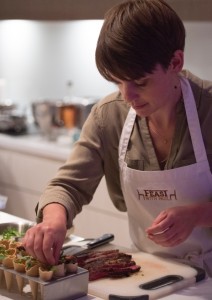
Lemon meringue tartlets
There was some interest in how to make an Italian meringue. I think most people were mentally skipping to the end when I would be shipping out the blowtorch again. However, as soon as someone said that her Italian meringues always collapsed, an element of jeopardy was introduced and people were watching intently.
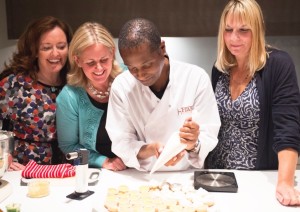
As the evening progressed, barriers came down. The questions were still coming thick and fast, but people were inching ever closer as they were eager to see how many of the techniques they had shied away from were being demonstrated in a relaxed environment.

Calvados soufflés with caramelised apple and salted caramel sauce
This is a great way to end an evening. It’s light but tastes so indulgent. You have the gentle warmth of the apple brandy. There is the airy lightness of the soufflé. At the bottom of the dish is a surprise of caramelised apples which introduce another dimension just as you think you have the dish figured out. Finally, the salted caramel sauce turns this into pure indulgence.

It was a thoroughly enjoyable evening. I can’t thank Sarah and Caroline enough for putting the event together. Also Dominique’s home created the perfect environment for the 20 guests to mingle and gather around the island for an up close and personal look at their food being prepared.
* If you do not have a meat thermometer, you can use the finger test.
Rare: Hold the tips of your thumb and index finger together. Using your other hand, press against the ball of your hand at the base of your thumb. It should feel springy. A rare steak should feel the same way.
Medium: Hold the tips of your thumb and third finger together. Using your other hand, press against the ball of your hand at the base of your thumb. This is how a medium steak should feel.
